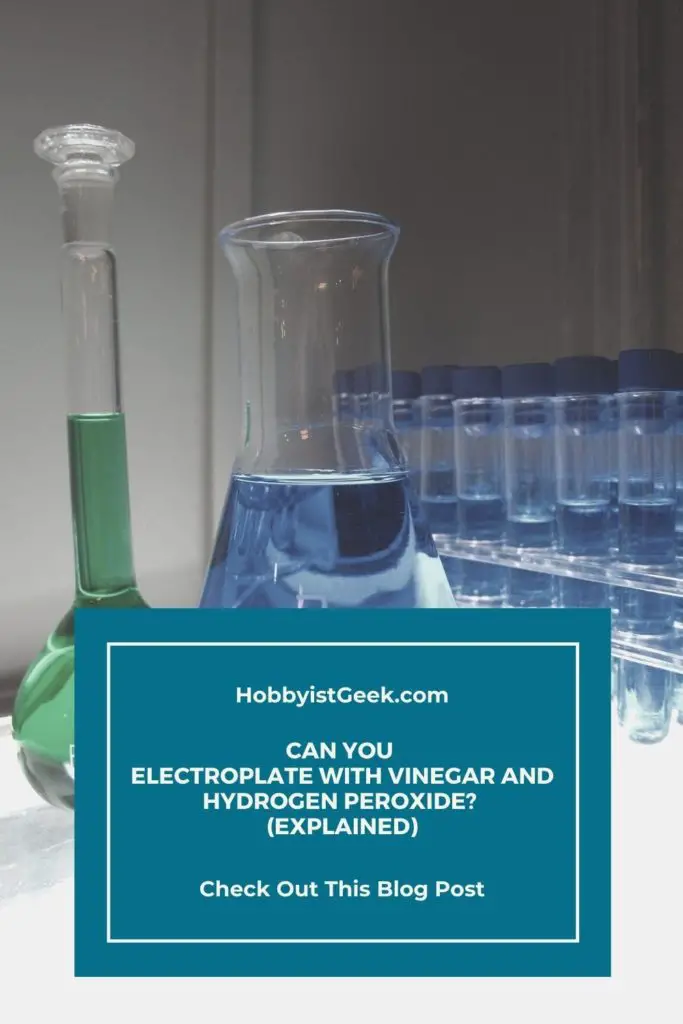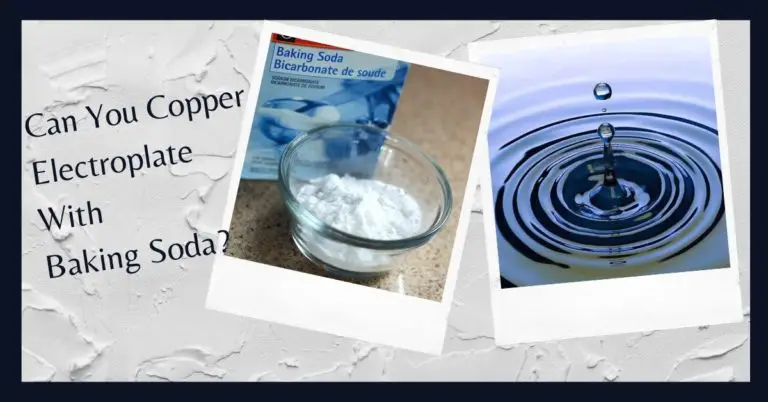Can You Electroplate With Vinegar And Hydrogen Peroxide? (Best Way)
I explain in this article Can You Electroplate With Vinegar And Hydrogen Peroxide? (Explained).
Electroplating, while similar to electroforming it’s far from the same.
Different situations require different techniques, and in this article, we’ll be discussing how you can electroplate objects, in particular how to do so using household items such as vinegar, and some cheap chemicals like Hydrogen Peroxide!
Can You Electroplate With Vinegar And Hydrogen Peroxide? (Best Way)
Electroplating is the process of applying a super thin layer of precious metal to a regular metal object, making it look like the entire object is made of precious metals, such as gold!
There are different ways to do this, one of which requiring vinegar and hydrogen peroxide, so yes it’s very much possible!
In this article, we’ll be answering all the questions mentioned before, as well as many more!
We’ll also look at the different ways of electroplating, when we’re done you’ll know everything you need to know to get to work yourself and start to carry out this wonderful hobby for yourself!
So, without further ado, let’s jump right into the action!
Materials
First off, let’s start our journey through the world of electroplating by taking a little look at materials, what do we need, and what materials can we use to electroplate?
In theory, you can electroplate any conductive metal, and even non-conductive metals using conductive paint. Most commonly, the base object is made of a cheap metal like Iron or Steel, this metal is then plated with more expensive material, such as silver or gold!
In order to electroplate, we’ll need several different materials.
These materials depend on the method of plating we choose to use, but they always include a power supply, wires, safety equipment such as gloves, and your materials, but more on the electroplating process later!
Please share this blog post on Pinterest.

Creating Your Electrolyte Solution Method #1
Before we can start electroplating anything, we have to start by making our electrolyte solution, this is the fluid we’ll use to put our materials in, and it’ll form the environment for the electroplating process to take place in!
As we’ve mentioned before, there are different methods of doing this, in this first method, we’ll use a mixture of Muriatic Acid and water to create our electrolyte solution!
As you might have guessed, we’re going to need Muriatic Acid, water, and an acid-proof container, any strong plastic or glass container will do perfectly fine!
That’s all we need! Now let’s get to the mixing, start by adding 5 parts of water to your container, then add 1 part of Muriatic acid to complete the 5:1 ratio mixture!
Always remember to add acid to water, and NOT the other way around, as this can cause a dangerous chemical reaction, always wear your protective safety gear!
Creating Your Electrolyte Solution Method #2
Now it’s time to look at another way of creating your electrolyte solution, using more household items, and we’ll be answering the title question, can you electroplate with vinegar and hydrogen peroxide?
The answer is clearly, yes, you can, but how? This method might be safer and more accessible, but it’s a little more difficult!
Start by mixing the vinegar and Hydrogen Peroxide in equal parts in your container, be sure to have enough to fully submerge your object later on.
From now on the solution should be handled with care, as mixing these two creates peracetic acid, always wear appropriate safety equipment, being gloves, a mask, eye protection, and a lab coat!
Heat the solution for a few minutes in the microwave, this will speed up the chemical reaction in the next step.
Continue by submerging copper wire into the solution, this creates a copper ion solution, which can be used to electroplate! Be sure to not overdo the copper in the solution, keep the solution’s color light blue for the best results.
Making Your Copper Electrode
Those of you that are familiar with the electroforming process, or with electricity in general, will know that for the electroplating process to take place, we’ll need an anode and a cathode, in simpler terms, a positive and a negative pole.
Our cathode will obviously be the object we’re looking to plate, but we’ll have to create our own anode, but how?
Take the remainders of the copper you used making your electrolyte solution, be sure to use 100% copper wire which can be bought in your local hardware store and roll it up into a teardrop shape!
Make sure to pack the fat end of the teardrop very tightly, this prevents it from floating, and voila, creating an anode was really that easy!
Place your anode as far to the side of the bath as possible and attach the positive wire to it.
High Quality (and Safe) Copper Plating
Prepare The Metal Object For Electroplating
With our electrolyte solution and our anode ready, there’s just one thing left to finalize, our cathode! In other words, the piece we’re electroplating.
We’ll need to prepare it for the electroplating process to ensure the optimal and shiny results we’re looking for, but how do we achieve this?
Start by removing most of the dirt and grease from your object with regular dish soap.
After that, we’ll have to remove the oxidation from the object to ensure good adhesion during the plating process.
To do this, we’ll use a chemical, such as Cameo stainless steel cleaner, but any steel cleaner will do, mix the cameo with some water to create a paste.
Then use this paste to thoroughly clean your object, you’re done when the object is no longer shiny, but appears dull and even!
Give it a final rinse off, and dry it with a paper towel, and we’re ready to go!
Electroplate The Metal Piece
With all the prep work out the way, it’s time to get to the fun stuff, the electroplating process! Unlike the electroforming process, electroplating takes a little more effort from our end!
We should start by properly setting up our electroplating setup.
Attach the positive wire to the proper terminal on the power supply, and attach the other end to our teardrop-anode, then do the same for the negative wire and the cathode!
Now that we’ve got our setup ready, it’s time to submerge our object, do this in one smooth movement, and start carefully rotating the object in the solution.
It’s important to keep the object moving to avoid burn marks and unsatisfactory results! You should now gently see a color change appear on the object, keep going until you see the metal forming, well done!
We’re now almost done with our electroplated piece, just one step left!
Shine And Protect The Metal
After the electroplating process, we’ll need to take some steps to make sure that we can enjoy our newly made piece for a long time to come!
To do this, we’ll need to polish our piece to make it nice and shiny, and we’ll need to protect our newly made layer from the dire consequences of oxidation, but how do we this?
To polish you can use any polishing agent, be sure to be very gentle though, as the newly created copper layer is very thin, much thinner than after the electroforming process, so it’s easily polished off!
You can then apply a clear coat to prevent further oxidation.
If you fount this article informative please check out What Is Silver Electroplating/Electroforming? (All You Need To Know)
Final Thoughts For Can You Electroplate With Vinegar And Hydrogen Peroxide? (Best Way)
There you have it, the complete electroplating process from start to finish! in the article Can You Electroplate With Vinegar And Hydrogen Peroxide? (Explained)
While being similar to electroforming, they’re not the same, but they can be used in harmony and for different purposes!
To quickly recap on the title question, can you electroplate with vinegar and hydrogen peroxide, yes you can!
There are different ways to electroplate, and we hope we’ve covered enough for you to get started on this wonderful art! Thank you for reading, and good luck electroplating!
Electroforming: The Ultimate Guide Check It Out!
Please share this blog post on Pinterest.

Sources in MLA Format:
A_Steingrube, and Instructables. “High Quality (and Safe) Copper Plating.” Instructables, Instructables, 20 Oct. 2017, www.instructables.com/High-Quality-Copper-Plating/.
Bess Ruff, MA. “How to Electroplate Household Metals.” WikiHow, WikiHow, 14 Apr. 2020, www.wikihow.com/Electroplate-Household-Metals.
“What Is Electroplating?” What Is Electroplating? | How Electroplating Works | SPC, www.sharrettsplating.com/about/what-electroplating.
- Evil Eye Hand: Unveiling the Mystical Origins and Meanings - February 2, 2024
- Amegreen Amethyst Meaning: Discover the Hidden Magic! - February 2, 2024
- Is The Evil Eye Bad?: A Deep Dive into Evil Eye Taboos - February 2, 2024








